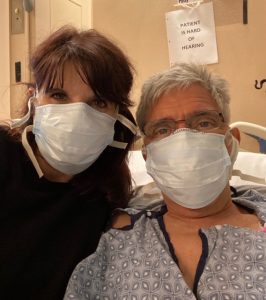Regaining My Strength and Stamina Following Heart Transplant

I never imagined my first episode of irregular heartbeats, or arrhythmias, in the late 1970s would lead to getting a heart transplant decades later.
When I had my first episode, I didn’t know I had Fabry disease. I also didn’t know that as a male with classic Fabry disease, I almost certainly would have significant heart problems at a relatively young age.
Without another reason to explain the arrhythmias, the cardiologist who evaluated me called my heart issue “holiday heart syndrome,” a term sometimes used for alcohol-related atrial fibrillation.
That diagnosis back in 1979 made sense to me. I had been out eating and drinking with friends late the night before, and I was driving home in a snowstorm. I started to feel my heart beating irregularly, which scared me. I drove straight to the hospital’s emergency room rather than going home.
That night was just the beginning. For many years, I experienced a variety of heart problems caused by Fabry disease and associated procedures, including:
- Frequent arrhythmias
- Surgery to insert an implantable cardioverter defibrillator, or ICD
- Cardioversion, which sends electric shocks to the heart to restore normal rhythm
- Cardiac ablation therapy, a procedure that scars tissue in the heart to block abnormal electrical signals
- Mitral valve surgery to repair a leaky valve
- A diagnosis of progressive heart failure
- ICD shock therapy, which sends electric shocks to the heart to restore normal rhythm
- Intra-aortic balloon pump therapy, in which a long balloon is inserted in the aorta and then inflated and deflated with heartbeats to help pump more blood
- And finally, a heart transplant.
Last year, my heart function declined even more than in previous years. In September, I was advised by a heart transplant team at Duke Health, in North Carolina, to come into the hospital to stay until I received a new heart.
Once in the hospital, a balloon pump was installed to temporarily improve my heart function. Then, I had to lie nearly flat on my back while I waited. Fortunately, two weeks later, a heart became available, and I was taken to the surgery unit for my life-changing procedure.
The eight-hour heart-transplant surgery and initial recovery went very well. A few days later, I walked a mile with a walker inside the hospital ward. Eight days after my transplant, I walked out of the Duke hospital to return home with a new lease on life.
I feel so much better with my new heart, and my health continues to improve every day. Now, I have an opportunity to steadily regain my strength, energy, and stamina, which will allow me to have a better life.
Changing from an increasingly sedentary lifestyle before my transplant to a more active lifestyle again is incredibly exciting. Of course, I still have to contend with the many other symptoms of Fabry disease, but my new heart should help the rest of my body stay healthier.
Transplant recovery has a lot of do’s and don’ts about medications, nutrition, exercise, and various activities. After my transplant, I began taking a variety of medications, including a few antirejection-immunosuppressant medications. Initially, I took 35 pills and one liquid medication daily, which has now been reduced gradually to 14 pills per day.
I have to take immunosuppressant medications for the rest of my life. The downside is that they make a person more susceptible to infections. I am also more susceptible to getting skin cancer. And just as we are experiencing with the COVID-19 pandemic, I must be careful around other people, especially children, who tend to be sick more often.
Even when the pandemic subsides, I still will need to protect myself from germs. I will wear a mask on airplanes and in crowds of people. Outdoor dining and takeout food will be safer for me than indoor dining.
The pandemic has provided a glimpse of how to protect myself in the future with frequent hand-washing, wearing a mask when necessary, and practicing some degree of social distancing. Thankfully, my wife, Angela, and I already have had our COVID-19 vaccinations.
Among other side effects, the transplant medications changed how food tastes. As we continue to reduce my medications, I am hopeful I’ll regain a normal sense of taste. Also, my skin is oilier, especially on my face, and my hair is thinner.
After a dozen heart biopsies, I am now on a biopsy schedule of every two months. I have had no signs of rejection yet, which is great!
The few disadvantages I am experiencing are insignificant compared to the positive changes in my health and the new opportunities ahead of me. Angela and I plan to spend more time outdoors again, traveling and visiting our friends and family, as pandemic restrictions allow. We also plan to take more walks and play more with our dogs Annah and Molly. I couldn’t participate in so many everyday activities with the weakness, fatigue, and shortness of breath I experienced before my transplant.
I also look forward to helping with the house and yard tasks that Angela has been doing so much. I am so thankful for Angela, but she needs some well-deserved help from the guy with the new heart.
***
Note: Fabry Disease News is strictly a news and information website about the disease. It does not provide medical advice, diagnosis, or treatment. This content is not intended to be a substitute for professional medical advice, diagnosis, or treatment. Always seek the advice of your physician or other qualified health provider with any questions you may have regarding a medical condition. Never disregard professional medical advice or delay in seeking it because of something you have read on this website. The opinions expressed in this column are not those of Fabry Disease News or its parent company, Bionews, and are intended to spark discussion about issues pertaining to Fabry disease.










Leave a comment
Fill in the required fields to post. Your email address will not be published.